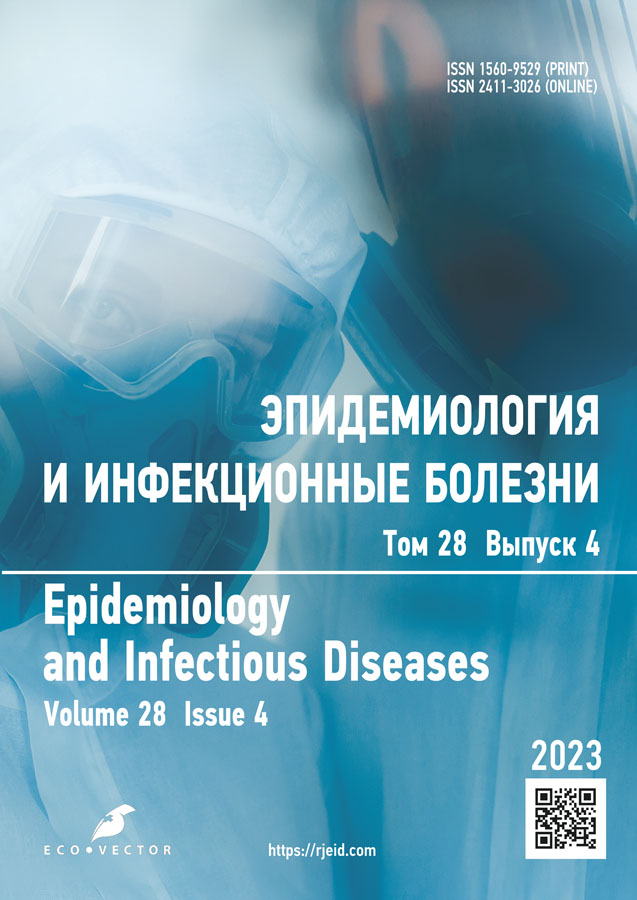Disinfection and sterilization measures in medical organizations of the Ural and Siberian Federal Districts: Results of 2022 and a long-term quality rating
- Authors: Smirnova S.S.1,2, Zhuikov N.N.1, Egorov I.A.1, Malkova E.V.1, Shelkova E.S.1, Stagilskaya Y.S.1
-
Affiliations:
- Federal Scientific Research Institute of Viral Infections “Virome”
- Ural State Medical University
- Issue: Vol 28, No 4 (2023)
- Pages: 242-262
- Section: Technical reports
- Submitted: 21.06.2023
- Accepted: 05.07.2023
- Published: 08.09.2023
- URL: https://rjeid.com/1560-9529/article/view/501791
- DOI: https://doi.org/10.17816/EID501791
- ID: 501791
Cite item
Abstract
BACKGROUND: Disinfection and sterilization activities are integral parts of the epidemiological safety system in healthcare aimed at preventing healthcare-associated infections. The quality of disinfection and sterilization activities affects healthcare efficiency and the safety of both patients and healthcare professionals. Continuous monitoring of key disinfection and sterilization indicators is an important constituent of a healthcare-associated infection surveillance system implemented in healthcare institutions, organizations, and bodies of Rospotrebnadzor (Federal Service for Surveillance on Consumer Rights Protection and Human Wellbeing).
AIM: To analyze data on the disinfection and sterilization activities implemented in healthcare institutions of the Ural and Siberian Federal Districts.
MATERIALS AND METHODS: Based on the information obtained from State Federal Statistical Monitoring form No. 27 “Information on disinfection activities” for 2015–2022 presented by the Rospotrebnadzor offices of the respective Russian Federation constituents, long-term average annual and Russia’s nationwide average figures were compared. The rating of the quality of disinfection and sterilization measures in the healthcare institutions of the Ural and Siberian Federal Districts was analyzed using Statistica 10, and the most significant groups of indicators were selected for analysis.
RESULTS: The resulting rating scores and their long-term annual kinetics suggest that the steadiest quality indicators of the disinfection and sterilization activities were observed in healthcare institutions in the Khakass Republic, Tyumen, and Omsk Oblasts.
CONCLUSIONS: Continuous monitoring of key disinfection and sterilization indicators in healthcare institutions allows the development of task-oriented preventive activities and their adjustment to changes in the epidemiologic situation in the region.
Full Text
About the authors
Svetlana S. Smirnova
Federal Scientific Research Institute of Viral Infections “Virome”; Ural State Medical University
Email: smirnova_ss69@mail.ru
ORCID iD: 0000-0002-9749-4611
SPIN-code: 3127-4296
https://www.facebook.com/profile.php?id=100006558874957
MD, Cand. Sci. (Med.), Associate Professor
Russian Federation, Yekaterinburg; YekaterinburgNikolai N. Zhuikov
Federal Scientific Research Institute of Viral Infections “Virome”
Email: zhuikov_nn@niivirom.ru
ORCID iD: 0000-0002-7018-7582
SPIN-code: 2218-5795
Russian Federation, Yekaterinburg
Ivan A. Egorov
Federal Scientific Research Institute of Viral Infections “Virome”
Email: egorov_ia@niivirom.ru
ORCID iD: 0000-0002-7153-2827
SPIN-code: 6465-0182
Russian Federation, Yekaterinburg
Elena V. Malkova
Federal Scientific Research Institute of Viral Infections “Virome”
Email: ismp@niivirom.ru
ORCID iD: 0000-0002-6647-9531
SPIN-code: 9781-3200
Russian Federation, Yekaterinburg
Elena S. Shelkova
Federal Scientific Research Institute of Viral Infections “Virome”
Email: shelkova_es@niivirom.ru
ORCID iD: 0000-0003-2837-375X
SPIN-code: 4387-0173
MD, Cand. Sci. (Med.)
Russian Federation, YekaterinburgYlia S. Stagilskaya
Federal Scientific Research Institute of Viral Infections “Virome”
Author for correspondence.
Email: stagilskaya_ys@niivirom.ru
ORCID iD: 0009-0000-9261-5624
SPIN-code: 2923-4892
Russian Federation, Yekaterinburg
References
- Popova AY, Ezhlova EB, Igonina EP, Melnikova AA, Frolova NV. Supervision over compliance with sanitary-epidemiological legislation in the provision of healthcare in order to ensure its quality and safety. Vestnik Roszdravnadzora. 2016;1:74–78. (In Russ).
- Goloshva EV, Markova KG, Aleshukina AV, et al. Monitoring the effectiveness of modern disinfectants used in one of the hospitals of Rostov-on-Don. Glavnyi vrach Yuga Rossii. 2023;(1(87)):52–55. (In Russ).
- Smetanin VN. Nekotorye aspekty nespetsificheskoi profilaktiki ISMP. Chronos: natural and technical sciences. 2020;5(3(31)):9–12. (In Russ).
- Sharafutdinova VI. Challenges in choosing disinfectants in medical organizations at the present time and ways to solve them. Arkhitektura zdorov’ya. 2022;1:29–41. (In Russ).
- Carling PC. Health care environmental hygiene: new insights and centers for disease control and prevention guidance. Infectious Disease Clinics of North America. 2021;35(3):609–629. doi: 10.1016/j.idc.2021.04.005
- Malyshev VV, Eremina SK. Primenenie sovremennykh dezinfitsiruyushchikh sredstv v tselyakh profilaktiki ISMP v usloviyakh aktivnoi tsirkulyatsii SARS-CoV-2. Forcipe. 2021;4(S2):97–98. (In Russ).
- Smirnova SS, Zhuikov NN, Egorov IA, Pushkareva NA, Semenov AV. Comparative analysis of methods of environmental surface sampling for assessment of viral and bacterial contamination. Zdorov’e Naseleniya i Sreda Obitaniya. 2023;31(4):77–84. (In Russ.) doi: 10.35627/2219-5238/2023-31-4-77-84
- Cruz-López F, Martinez-Meléndez A, Garza-González E. How does hospital microbiota contribute to healthcare-associated infections? Microorganisms. 2023;11(1):192. doi: 10.3390/microorganisms11010192
- D’Accolti M, Soffritti I, Mazzacane S, Caselli E. Fighting AMR in the healthcare environment: microbiome-based sanitation approaches and monitoring tools. International Journal of Molecular Sciences. 2019;20(7):1535. doi: 10.3390/ijms20071535
Supplementary files























